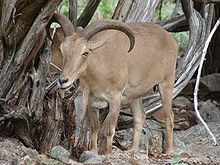Barbary sheep
| Barbary sheep | |
|---|---|
 |
|
| Barbary Sheep | |
| Scientific classification | |
| Kingdom: | Animalia |
| Phylum: | Chordata |
| Class: | Mammalia |
| Order: | Artiodactyla |
| Family: | Bovidae |
| Subfamily: | Caprinae |
| Genus: |
Ammotragus Blyth, 1840 |
| Species: | A. lervia |
| Binomial name | |
|
Ammotragus lervia (Pallas, 1777) |
|
| Subspecies | |
|
A. l. angusi Rothschild, 1921 |
|
| Synonyms | |
|
Antilope lervia |
|
A. l. angusi Rothschild, 1921
A. l. blainei Rothschiild, 1913
A. l. lervia Pallas, 1777
A. l. fassini Lepri, 1930
A. l. ornatus † I. Geoffroy Saint-Hilaire, 1827
A. l. sahariensis Rothschild, 1913
Antilope lervia
Capra lervia
The Barbary sheep (Ammotragus lervia) is a species of caprid (goat-antelope) native to rocky mountains in North Africa. Six subspecies have been described. Although it is rare in its native North Africa, it has been introduced to North America, southern Europe, and elsewhere. It is also known as aoudad, waddan, arui, and arruis.
Barbary sheep stand 80 to 100 cm (2.6 to 3.3 ft) tall at the shoulder and weigh 40 to 140 kg (88 to 309 lb). They are sandy-brown, darkening with age, with a slightly lighter underbelly and a darker line along the back. Upper parts and the outer parts of the legs are a uniform reddish brown or grayish brown. There is some shaggy hair on the throat (extending down to the chest in males) and a sparse . Their horns have a triangular cross section. The horns curve outward, backward, then inward, and reach up to 50 cm (20 in). The horns are fairly smooth, with slight wrinkles evident at the base as the animal matures.
Barbary sheep naturally occur in northern Africa in Algeria, Tunisia, northern Chad, Egypt, Libya, northern Mali, Mauritania, Morocco, Niger and Sudan (west of the Nile, and in the Red Sea Hills east of the Nile).
...
Wikipedia

